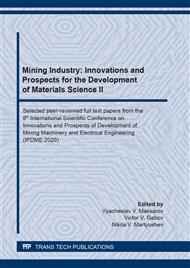[1]
M.C. Anderson, Y.C. Shin, Laser-assisted machining of an austenitic stainless steel: P550, Proc. Inst. Mech. Eng. Part B J. Eng. Manuf. 220 (2006) 2055–(2067).
DOI: 10.1243/09544054jem562
Google Scholar
[2]
B.X. Wang, X.H. Liu, G.D. Wang, Dynamic recrystallization behavior and microstructural evolution in a Mn-Cr gear steel, Mater. Sci. Eng. A. 393 (2005) 102–108.
DOI: 10.1016/j.msea.2004.09.042
Google Scholar
[3]
V. Maksarov, V. Krasnyy, The Formation of Surface Roughness of Piston Rings for the Purpose of Improving the Adhesion of Wear-Resistant Coatings, Key Eng. Mater. 736 (2017) 73–78.
DOI: 10.4028/www.scientific.net/kem.736.73
Google Scholar
[4]
I. Gibson, D. Rosen, B. Stucker, Directed Energy Deposition Processes, in: Addit. Manuf. Technol., Springer New York, New York, NY, 2015, p.245–268.
DOI: 10.1007/978-1-4939-2113-3_10
Google Scholar
[5]
S.M. Thompson, L. Bian, N. Shamsaei, A. Yadollahi, An overview of Direct Laser Deposition for additive manufacturing; Part I: Transport phenomena, modeling and diagnostics, Addit. Manuf. 8 (2015) 36–62.
DOI: 10.1016/j.addma.2015.07.001
Google Scholar
[6]
P. Guo, B. Zou, C. Huang, H. Gao, Study on microstructure, mechanical properties and machinability of efficiently additive manufactured AISI 316L stainless steel by high-power direct laser deposition, J. Mater. Process. Technol. 240 (2017) 12–22.
DOI: 10.1016/j.jmatprotec.2016.09.005
Google Scholar
[7]
M. Ziętala, T. Durejko, M. Polański, I. Kunce, T. Płociński, W. Zieliński, M. Łazińska, W. Stępniowski, T. Czujko, K.J. Kurzydłowski, Z. Bojar, The microstructure, mechanical properties and corrosion resistance of 316L stainless steel fabricated using laser engineered net shaping, Mater. Sci. Eng. A. 677 (2016) 1–10.
DOI: 10.1016/j.msea.2016.09.028
Google Scholar
[8]
P. Xu, C. Lin, C. Zhou, X. Yi, Wear and corrosion resistance of laser cladding AISI 304 stainless steel/Al2O3 composite coatings, Surf. Coatings Technol. 238 (2014) 9–14.
DOI: 10.1016/j.surfcoat.2013.10.028
Google Scholar
[9]
W. Huang, Y. Zhang, W. Dai, R. Long, Mechanical properties of 304 austenite stainless steel manufactured by laser metal deposition, Mater. Sci. Eng. A. 758 (2019) 60–70.
DOI: 10.1016/j.msea.2019.04.108
Google Scholar
[10]
Y. Chew, J.H.L. Pang, G. Bi, B. Song, Effects of laser cladding on fatigue performance of AISI 4340 steel in the as-clad and machine treated conditions, J. Mater. Process. Technol. 243 (2017) 246–257.
DOI: 10.1016/j.jmatprotec.2016.12.020
Google Scholar
[11]
G. Chakraborty, C.R. Das, S.K. Albert, A.K. Bhaduri, S. Murugesan, A. Dasgupta, Effect of Alloy 625 Buffer Layer on Hardfacing of Modified 9Cr-1Mo Steel Using Nickel Base Hardfacing Alloy, J. Mater. Eng. Perform. 25 (2016) 1663–1672.
DOI: 10.1007/s11665-016-1965-z
Google Scholar
[12]
K. Feng, Y. Chen, P. Deng, Y. Li, H. Zhao, F. Lu, R. Li, J. Huang, Z. Li, Improved high-temperature hardness and wear resistance of Inconel 625 coatings fabricated by laser cladding, J. Mater. Process. Technol. 243 (2017) 82–91.
DOI: 10.1016/j.jmatprotec.2016.12.001
Google Scholar
[13]
D. Masaylo, S. Igoshin, A. Popovich, V. Popovich, Effect of process parameters on defects in large scale components manufactured by direct laser deposition, Mater. Today Proc. (2020).
DOI: 10.1016/j.matpr.2020.01.519
Google Scholar
[14]
D. V. Masaylo, A. V. Orlov, S.D. Igoshin, Effect of Heat Treatment on the Structure and Phase Composition of a High-Temperature Nickel Alloy Obtained by Laser Cladding, Met. Sci. Heat Treat. 60 (2019) 728–733.
DOI: 10.1007/s11041-019-00347-9
Google Scholar
[15]
H.I. Kim, H.S. Park, J.M. Koo, S.H. Yang, M.Y. Kim, C.S. Seok, Welding Characteristic Evaluation of GMAW and Laser Cladding for the Gas Turbine 1st Blade, Key Eng. Mater. 353–358 (2007) 519–522.
DOI: 10.4028/www.scientific.net/kem.353-358.519
Google Scholar


